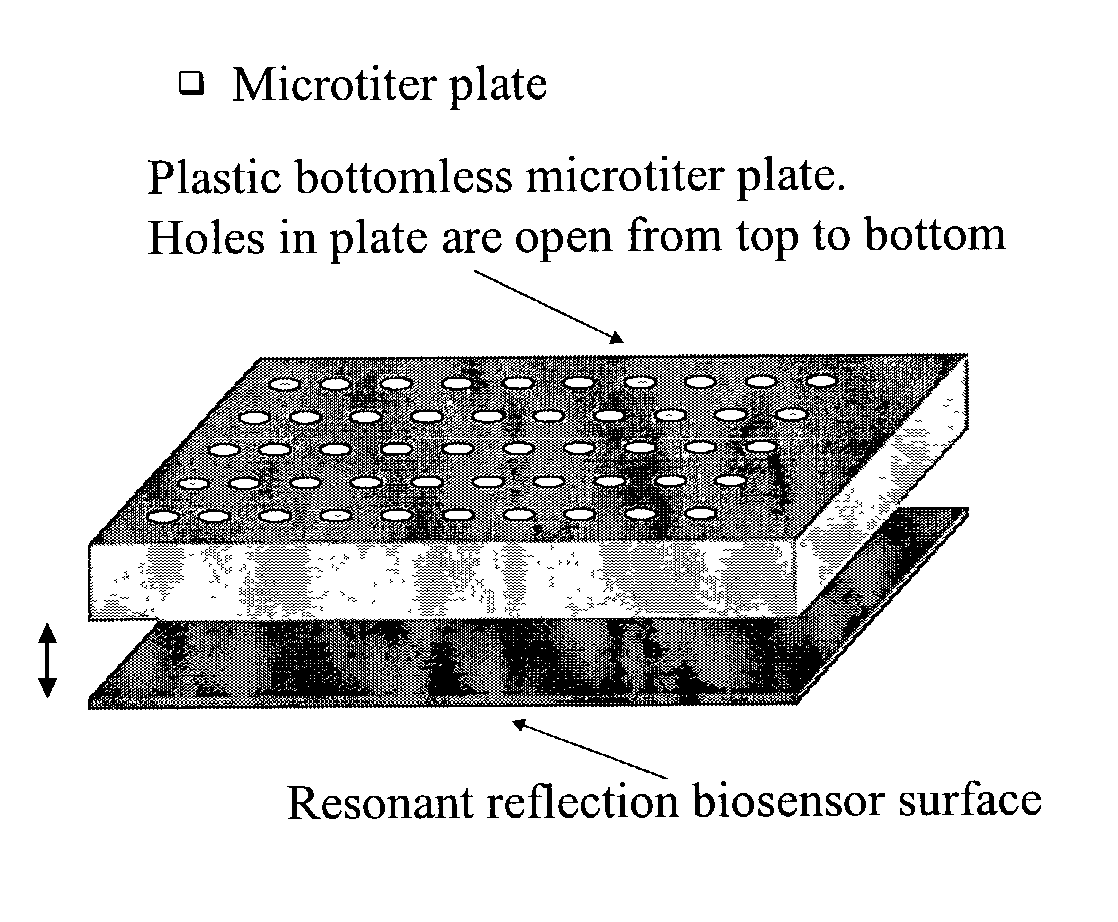Label-free methods for performing assays using a colorimetric resonant reflectance optical biosensor
a biosensor and colorimetric resonant technology, applied in the field of label-free methods for performing assays using a colorimetric resonant reflectance optical biosensor, can solve the problem that methods have yet to yield commercially available high-throughput instruments, and achieve the effect of relative effectiveness
- Summary
- Abstract
- Description
- Claims
- Application Information
AI Technical Summary
Benefits of technology
Problems solved by technology
Method used
Image
Examples
example 1
Immobilized Protein Detection
[0171]In order to demonstrate a biosensor's ability to quantify biomolecules on its surface, droplets of BSA dissolved in H2O at various concentrations were applied to a biosensor as shown in FIG. 1. The 3 μl droplets were allowed to dry in air, leaving a small quantity of BSA distributed over a ˜2 mm diameter area. The peak resonant wavelength of each biosensor location was measured before and after droplet deposition, and the peak wavelength shift was recorded. See FIG. 34.
example 2
Immobilization of One or More Specific Binding Substances
[0172]The following protocol was used on a colorimetric resonant reflective biosensor to activate the surface with amine functional groups. Amine groups can be used as a general-purpose surface for subsequent covalent binding of several types of linker molecules.
[0173]A glass substrate biosensor of the invention is cleaned by immersing it into piranha etch (70 / 30% (v / v) concentrated sulfuric acid / 30% hydrogen peroxide) for 12 hours. The biosensor was washed thoroughly with water. The biosensor was dipped in 3% 3-aminopropyltriethoxysilane solution in dry acetone for 1 minute and then rinsed with dry acetone and air-dried. Alternatively, immersion of the biosensor in 10% 3-aminopropyltriethoxysilane (Pierce) solution in ethanol (Aldrich) for 1 min, followed by a brief ethanol rinse. Activated sensors were then dried at 70° C. for 10 minutes. The biosensor was then washed with water.
[0174]A semi-quantitative method is used to ve...
example 3
IgG Assay
[0182]As an initial demonstration for detection of biochemical binding, an assay was performed in which a biosensor was prepared by activation with the amino surface chemistry described in Example 2 followed by attachment of a biotin linker molecule. The biotin linker is used to specifically interact with and effectively tether a streptavidin receptor molecule to the surface by exposure to a 50 μg / ml concentration solution of streptavidin in PBS at room temperature for 2–4 hours. The streptavidin receptor is capable of binding any biotinylated protein to the biosensor surface. For this example, 3 μl droplets of biotinylated anti-human IgG in phosphate buffer solution (PBS) were deposited onto 4 separate locations on the biosensor surface at a concentration of 200 μg / ml. The solution was allowed to incubate on the biosensor for 30 minutes before rinsing thoroughly with PBS. The peak resonant wavelength of the 4 locations were measured after biotin activation, after streptavi...
PUM
| Property | Measurement | Unit |
|---|---|---|
| diameter | aaaaa | aaaaa |
| diameter | aaaaa | aaaaa |
| molecular weight | aaaaa | aaaaa |
Abstract
Description
Claims
Application Information
 Login to View More
Login to View More - R&D
- Intellectual Property
- Life Sciences
- Materials
- Tech Scout
- Unparalleled Data Quality
- Higher Quality Content
- 60% Fewer Hallucinations
Browse by: Latest US Patents, China's latest patents, Technical Efficacy Thesaurus, Application Domain, Technology Topic, Popular Technical Reports.
© 2025 PatSnap. All rights reserved.Legal|Privacy policy|Modern Slavery Act Transparency Statement|Sitemap|About US| Contact US: help@patsnap.com



